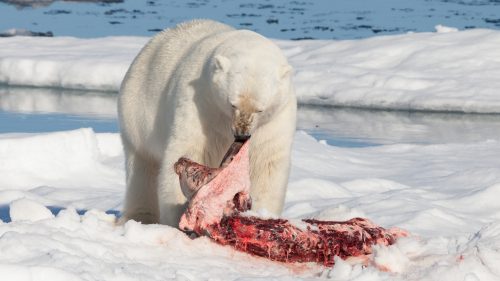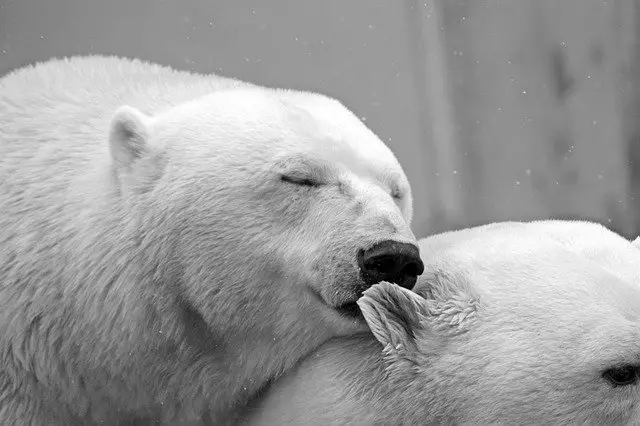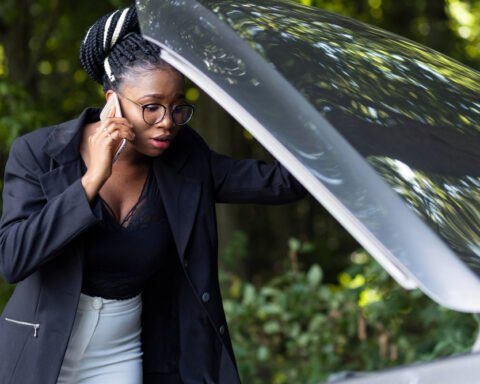Hey little explorers! Today, we’re going on an exciting journey to learn some amazing polar bear facts for preschoolers. Polar bears are not just any bears; they are special and super interesting! Imagine a big, fluffy bear, as white as snow, roaming around the icy lands way up in the North. That’s a polar bear!
Polar bears are like the kings and queens of the snowy world. They love the cold and live in a place called the Arctic, where it’s chilly and full of ice and snow. These bears are really big, but they’re also super friendly in stories and love to play and slide on the ice.
Did you know that polar bears have a secret trick? Their fur looks white, but it’s actually not! It’s see-through, like a clear window, but it looks white because of the snow. And they have thick, warm skin underneath to keep them cozy in the cold.
So, are you ready to find out more about these wonderful, snowy bears? Let’s go on this fun adventure together and learn all about polar bears!
What is a Polar Bear?
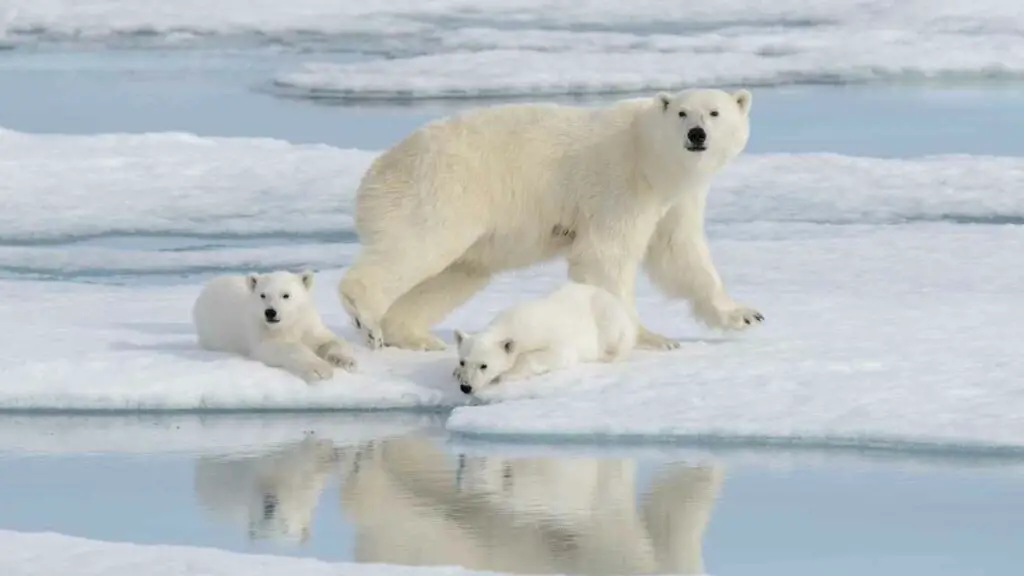
Hey, little friends! Let’s talk about what a polar bear is. A polar bear is a big, wonderful animal that lives where it’s super cold. They are the largest bears on Earth and are really strong and powerful. But, even though they are big, they are also very good at swimming. That’s right, polar bears are excellent swimmers!
These furry friends have thick, white fur that keeps them warm in the freezing Arctic, where they live. Underneath their fluffy coat, they have a layer of fat, kind of like a snug, warm blanket, that helps them stay warm in the icy cold weather.
Polar bears have big paws, which they use to walk on the snow and swim in the water. Their paws are so big that they don’t sink into the snow – just like wearing snowshoes! And when they swim, their paws help them paddle through the water, just like oars on a boat.
But do you know what’s really cool about polar bears? They can smell their food from far away, even when it’s hidden under the snow. They mostly eat seals, which they catch from holes in the ice.
Polar bears are amazing creatures, and learning polar bear facts for preschoolers like you is so much fun! They show us how animals can live and be happy even in the coldest places on Earth.
How Do Polar Bears Look?
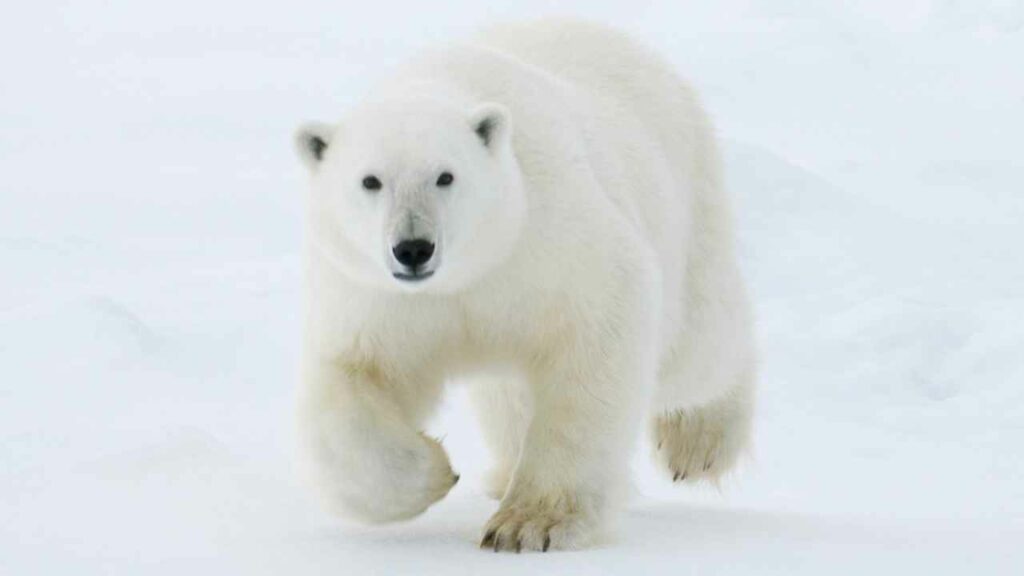
Have you ever wondered how polar bears look? Let’s paint a picture with words about these magnificent snowy animals!
Fluffy White Fur: The most special thing about polar bears is their fluffy, white fur. This fur is super thick and helps them stay warm in the freezing Arctic. It’s like wearing a cozy, warm coat all the time! And guess what? Each hair is like a tiny, clear tube. It’s not really white but looks that way because of the snow and light.
Big and Strong: Polar bears are really big! They are the largest meat-eating animals that live on land. Imagine your bed; a grown-up polar bear can be as long as that, from its nose to the tip of its tail. They are strong and powerful, with big muscles to help them walk on ice and snow.
Huge Paws: Look at your hands and feet. Now, think of them being really, really big! That’s how a polar bear’s paws are. Their paws are so big that they help the bear not to sink into the snow. They act like natural snowshoes. And when they swim, these paws are like paddles, helping them move through the water.
Sharp Claws and Teeth: Polar bears have sharp claws and big teeth. They use their claws to catch their food and to walk on slippery ice without falling. Their teeth are strong, perfect for eating their favorite food, like fish and seals.
Small Ears and Tail: Have you noticed how small a polar bear’s ears and tail are? They are tiny compared to their big body. This helps them to stay warm because less cold air can touch their skin.
Black Skin: Under all that fur, a polar bear’s skin is black! This helps them soak up the sun’s warmth, like wearing a dark shirt on a sunny day.
Aren’t polar bears amazing? They are perfectly made to live in their cold, snowy homes. Remember, these are special animals that we need to care for and protect.
Polar Bear Homes
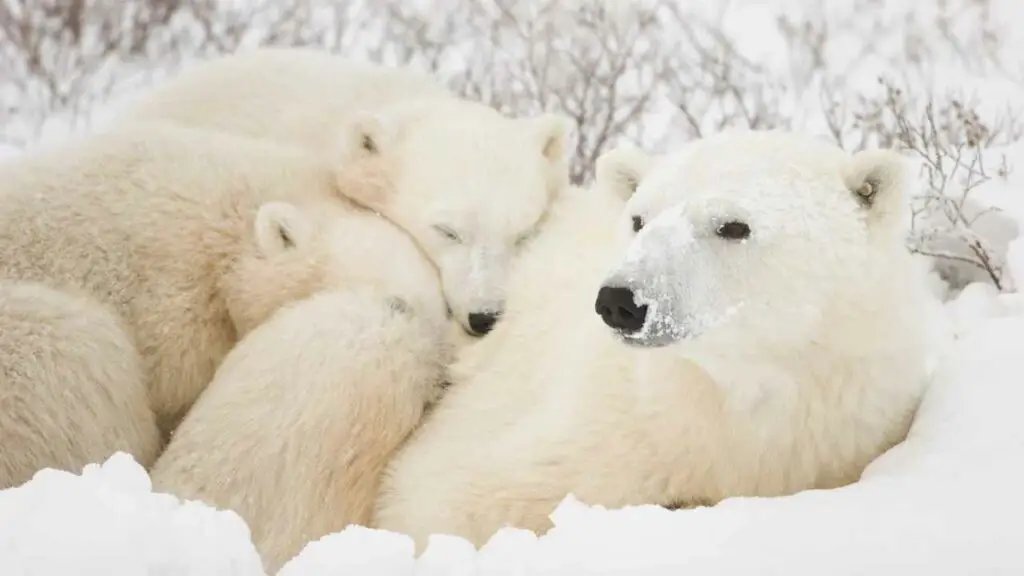
Guess where polar bears live? In a super cool place called the Arctic! The Arctic is way up at the top of the world, and it’s like a giant, snowy playground for polar bears.
A Land of Ice and Snow: The Arctic is very cold and covered in ice and snow. It’s like winter all the time! There are big chunks of ice floating in the sea, called icebergs, and the ground is often frozen. But for polar bears, this is the perfect home. They love the cold and are great at living in this snowy wonderland.
Where Do They Sleep?: You might wonder where polar bears sleep since there are no beds in the Arctic. Well, they make their own beds in the snow! They find a cozy spot, dig a little, and curl up to take a nap. Sometimes, they even dig big dens in the snow to stay warm and safe, especially when they have little baby bears, called cubs.
Playing and Hunting: Polar bears spend a lot of time playing and hunting in their Arctic home. They slide on the ice, swim in the cold water, and sometimes they even play with chunks of snow, just like you play with your toys! When they’re hungry, they go hunting for food, like seals, which they catch from holes in the ice.
Changing Seasons: Even in the Arctic, the seasons change. In the summer, it’s still cold, but the sun stays up for a long time, even at night! And in the winter, it’s very dark, with very long nights. But no matter what, polar bears are great at living in this special place all year round.
A Beautiful, Quiet World: The Arctic is a quiet, peaceful place, with lots of space and beautiful sights, like the Northern Lights, which are like colorful, dancing lights in the sky. It’s important to keep this place clean and safe for the polar bears and all the other animals that live there.
Isn’t it amazing to think about polar bears living in such a cool, snowy place? They really are special animals with a very special home!
What Do Polar Bears Eat?
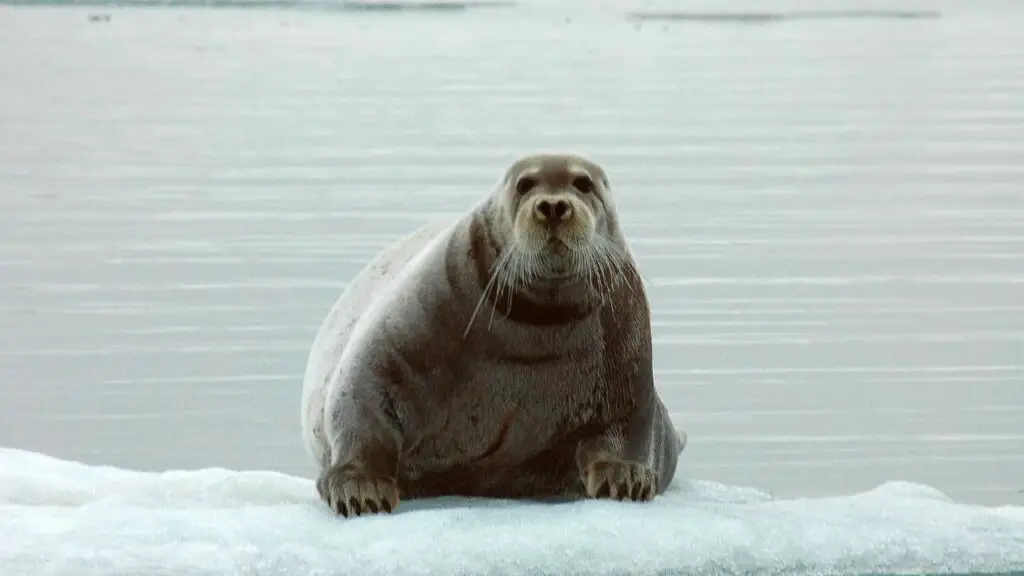
Have you ever wondered what a big, strong polar bear likes to eat? Let’s dive into the world of polar bear snacks and meals!
Seal Suppers: The favorite food of polar bears is seals. They are really good at hunting them. Polar bears wait quietly by a hole in the ice, and when a seal comes up to breathe, they catch it! It’s like playing a game of hide and seek with their dinner.
Fishy Treats: Sometimes, polar bears also eat fish. They catch the fish right out of the water. Imagine trying to grab a wiggly fish with your hands – that’s what polar bears do with their sharp claws!
Berry Delicious: Even though polar bears mostly eat meat, they sometimes eat berries too. In the summer, when there are no seals around, they munch on berries they find on the ground. It’s like having a little snack between meals.
A Big Appetite: Polar bears eat a lot when they can, especially before winter. They need to store energy in their bodies to keep them warm and full during the long, cold months when food is hard to find.
Activity Time!: Let’s play a fun game. Can you pretend to be a polar bear and show how you would catch a fish or pick berries? Remember, polar bears use their paws for everything!
A Balanced Diet: Just like you, polar bears need to eat different things to stay healthy. They are really good at finding food in their cold, snowy home.
Isn’t it interesting to learn about what polar bears eat? They are great hunters and know exactly how to find their food in the Arctic!
Growing Up Polar Bear
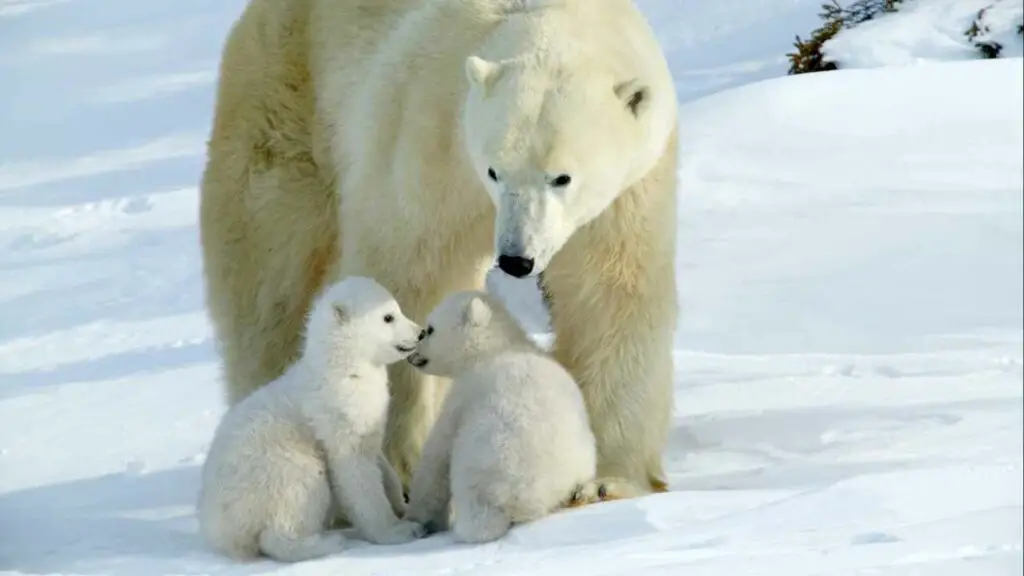
Let’s take a peek into the life of a polar bear as it grows from a tiny cub into a big, strong adult. It’s a journey full of adventure and learning!
Tiny, Cuddly Cubs: Polar bear babies are called cubs. When they are born, they are very small, about the size of a guinea pig. They can’t see or hear and stay close to their mom in a warm den in the snow. These dens are like cozy bedrooms where they are safe and warm.
Learning with Mom: As the cubs grow a little bigger, they start to explore outside the den. They play, tumble in the snow, and learn important polar bear skills from their mom. She teaches them how to hunt, swim, and survive in the Arctic. It’s like going to school, but their mom is the teacher, and the Arctic is their classroom!
Growing Bigger and Stronger: Polar bear cubs drink their mom’s milk, which helps them grow big and strong. They start off tiny, but grow quickly! By the time they are a few months old, they are ready to follow their mom and learn about the wide, snowy world.
Becoming Independent: When polar bear cubs are about two or three years old, they are big enough to start living on their own. This is when they leave their mom and start their own polar bear adventures. They have learned all they need to know to be great polar bears.
Full-Grown Polar Bears: As they grow, they become strong and skilled hunters, just like their moms. They roam the Arctic, swim in the cold waters, and become the kings and queens of their snowy world.
A Circle of Life: One day, these grown-up polar bears might have cubs of their own, and the cycle starts all over again. Each generation of polar bears learns how to live in the beautiful, chilly Arctic, just like their parents before them.
Isn’t it amazing how polar bears grow and learn? From tiny cubs to big, majestic adults, every stage of their life is an exciting adventure in the Arctic!
Playtime in the Arctic
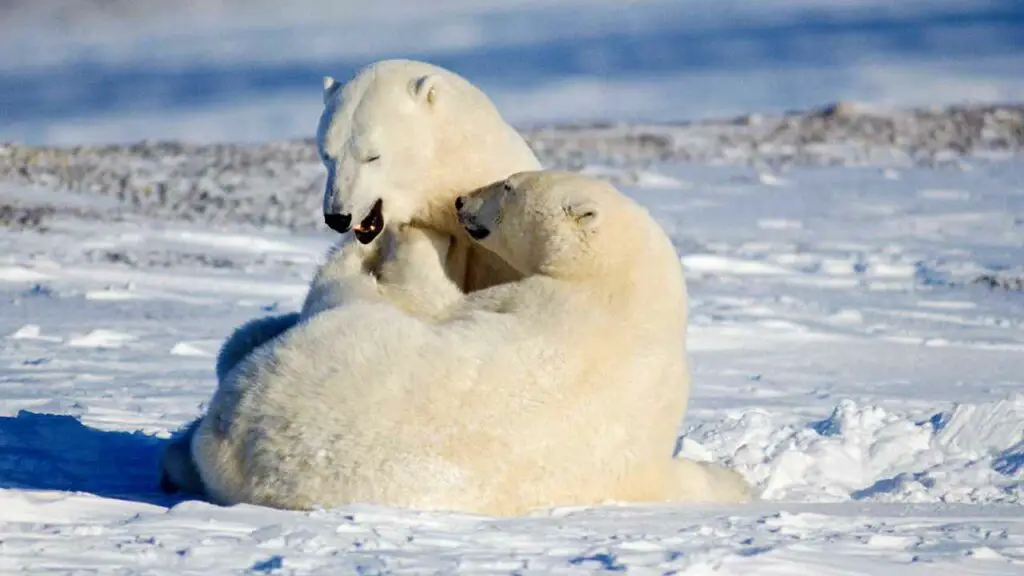
Did you know that polar bears love to play just like you do? Let’s explore how these big, fluffy bears have fun in their snowy home, the Arctic!
Snowy Slides and Dives: One of the coolest things polar bears do is slide on the ice and snow. They use their big bellies to glide smoothly – it’s like they have their own snow slide! Sometimes, they dive into the snow and pop back out, just like playing in a big pile of fluffy pillows.
Wrestling Matches: Young polar bears, especially brothers and sisters, love to wrestle with each other. They tumble, roll, and gently bite, but it’s all in good fun. It’s their way of playing and learning how to be strong. Think of it like your playtime with friends or siblings, but in the snow!
Swimming Races: Polar bears are great swimmers, and they sometimes play in the water. They can swim for miles and miles without getting tired. Imagine having a swimming race with a polar bear – they would probably win!
Chasing and Pouncing: Sometimes, polar bears chase each other or pounce on things in the snow. It’s like they’re playing a game of tag or hide-and-seek with the snowflakes and ice.
Fun Fact: Did you know that when polar bears meet each other, they often touch noses and sniff as a way of saying hello? It’s their special way of greeting friends!
Learning Through Play: All this play is not just fun; it’s also how polar bears learn important skills for when they grow up. They learn how to hunt, how to fight, and how to be strong and smart in the Arctic.
Polar bears might be big, but they love to have fun and play, just like you! Their Arctic home is a giant playground where every day is a new adventure.
Polar Bear Families
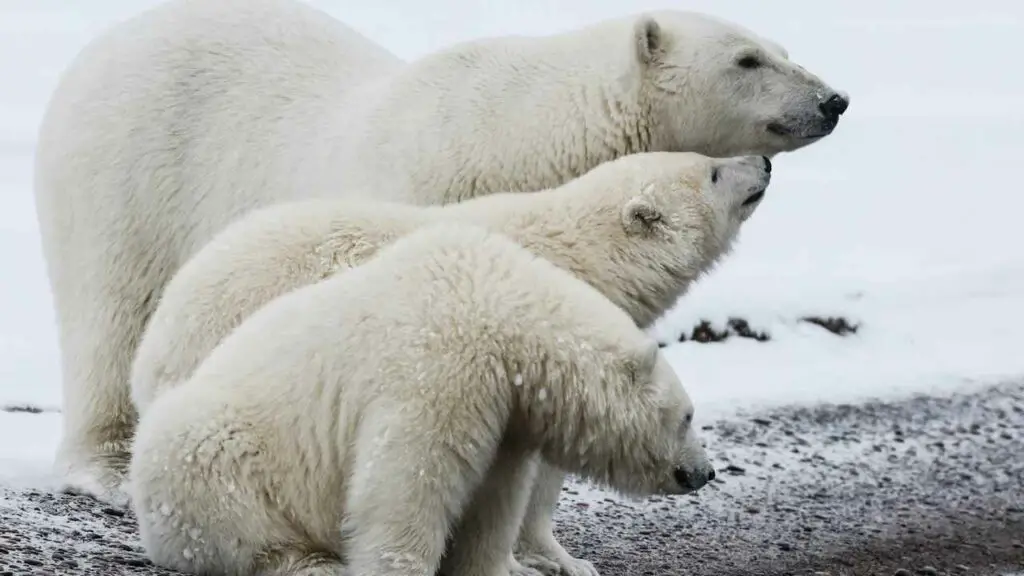
In the snowy world of the Arctic, polar bear families share a very special bond, especially between mother bears and their cubs. Let’s take a peek into their family life!
A Mother’s Care: The story of a polar bear family starts when the mother bear gives birth to her cubs in a cozy snow den. These cubs are tiny and need a lot of care. The mother bear is very gentle and loving. She keeps them warm, feeds them with her milk, and cuddles them close. It’s like a big, warm bear hug!
First Steps into the World: When the cubs are a few months old, the mother bear takes them outside for the first time. Imagine seeing the big, wide world for the first time! The cubs are curious and playful, and their mom is always there to watch over them and keep them safe.
Learning and Exploring: The mother bear teaches her cubs everything they need to know about living in the Arctic. She shows them how to find food, how to swim, and how to protect themselves. It’s like going to school, but their mom is the teacher, and the lessons are about how to be a great polar bear.
Growing Up Together: The cubs stay with their mom for about two to three years. During this time, they grow strong and learn a lot. They play, explore, and learn together. It’s a time full of adventure and fun!
Saying Goodbye: Eventually, when the cubs are big enough, they leave their mother to start their own journeys. It might be a little sad to say goodbye, but it’s a natural part of growing up for polar bears. They are now ready to explore the Arctic on their own and maybe one day have families of their own.
A Mother’s Love: The bond between a mother polar bear and her cubs is very strong and beautiful. She teaches them, protects them, and loves them, preparing them for life in the Arctic.
Polar bear families show us how caring and loving animals can be. The mother bear’s dedication to her cubs is a wonderful example of a family’s love and strength.
Staying Warm in the Cold
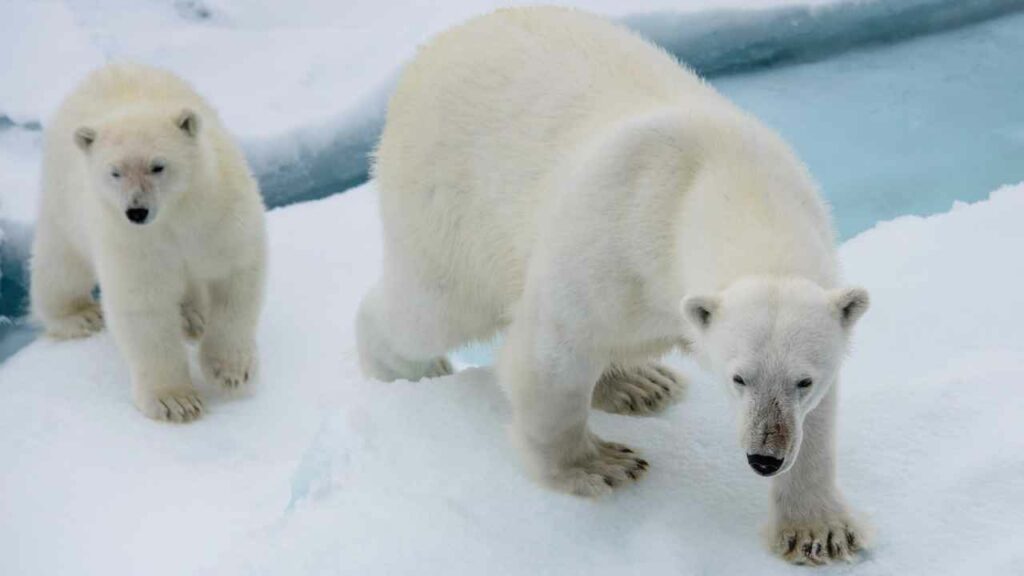
Brrr! The Arctic is a very cold place, but polar bears have some amazing ways to stay warm and cozy. Let’s discover how these fluffy giants keep toasty in the chilly Arctic!
Thick, Fluffy Fur: Polar bears have super thick fur that keeps them warm. It’s like wearing a big, fluffy coat all the time. This fur is so good at keeping them warm that they can even take a nap in the snow without feeling cold!
A Layer of Fat: Under their fur, polar bears have a thick layer of fat. This fat is like a snug blanket that keeps their body heat inside, so they don’t get cold. It’s like having a built-in heater!
Big Paws for Snow: Have you ever tried walking in deep snow? It can be hard! But polar bears have huge paws that spread out their weight, so they don’t sink into the snow. It’s like having snowshoes on their feet.
Small Ears and Tail: Polar bears have small ears and tails. Why? Because smaller body parts lose less heat. It’s like wrapping up in a tight ball to stay warm – the less you stick out, the warmer you stay.
Black Skin to Soak Up the Sun: Did you know that under all that fur, a polar bear’s skin is black? Black absorbs more heat from the sun, which helps them stay warm.
Activity Time!: Let’s pretend to be a polar bear! Put on your warmest coat and pretend it’s your fur. Now, walk around with wide steps like you have big polar bear paws. How does it feel to walk like a polar bear in the snow?
Polar bears are amazing at staying warm, even in the coldest places on Earth. With their thick fur, fat layer, and big paws, they are perfectly dressed for a winter wonderland all year round!
Helping Our Polar Bear Friends

Polar bears are not just amazing and fun to learn about, but they also need our help to stay safe and happy. Let’s find out how we can be heroes for our polar bear friends!
Keeping Their Home Clean: The Arctic, where polar bears live, is a beautiful place, but it needs to be clean and safe. We can help by making sure we don’t litter and by recycling at home. Every little bit helps, even if we live far away!
Using Less Energy: Polar bears need ice to live, but the Earth is getting warmer, and the ice is melting. We can help by saving energy – like turning off lights when we leave a room or walking instead of using the car. This helps our planet stay cooler.
Learning and Sharing: The more we learn about polar bears, the more we can help them. Share what you know with your friends and family. When more people know about polar bears, more people will want to help them.
Supporting the Helpers: There are lots of scientists and groups who work hard to protect polar bears. We can support them by learning about their work and even donating to their causes if we can.
Activity Time!: Let’s draw a picture of a polar bear in a clean, icy home. You can show the bear playing, swimming, or just relaxing. This picture can remind us to always care for our planet and our animal friends.
Remember, even though we’re small, we can do big things to help our polar bear friends and our planet. Every little action counts, and together, we can make a big difference!
Amazing Polar Bear Facts
Polar bears are full of surprises! Here are some super cool facts about these amazing Arctic animals that will make you say “Wow!”
- Invisible Fur: Even though polar bear fur looks white, it’s actually clear! Each hair is like a hollow tube. The fur looks white because it reflects light, just like snow.
- Super Swimmers: Polar bears are excellent swimmers. They can swim for miles and miles without getting tired. Some have been seen swimming over 60 miles without a break!
- Biggest Bear: Did you know that polar bears are the largest land predators in the world? That’s right, they are even bigger than grizzly bears!
- Noisy Noses: When polar bears meet, they greet each other by touching noses and sniffing. It’s their way of saying hello!
- Paw Size: A polar bear’s paw is about the size of a dinner plate! These big paws help them walk on thin ice without falling through.
- Super Sense of Smell: Polar bears have an amazing sense of smell. They can smell a seal from almost a mile away and under several feet of compacted snow.
- Lots of Names: In different parts of the world, polar bears have different names. Some people call them “sea bears” because they are so good at swimming.
- Cubs’ First Swim: Baby polar bears learn to swim when they are very young. Their first swim is with their mom, who teaches them how to paddle in the icy waters.
- Long Naps: Polar bears don’t hibernate like some bears, but they do take long naps during the winter. They can sleep for days when the weather is very cold!
- A Bear’s Diet: While they mostly eat seals, polar bears can also eat birds, eggs, and sometimes even berries and plants.
Aren’t these facts about polar bears amazing? They are such interesting and incredible animals with so many unique qualities!
Interactive Elements
Let’s make learning about polar bears even more fun with some interactive activities and questions! Are you ready to play and learn?
1. Polar Bear Quiz Time!
- Question: What do polar bears eat the most?
- A) Berries
- B) Fish
- C) Seals
- Question: What color is a polar bear’s skin?
- A) White
- B) Black
- C) Brown
- Question: How do polar bears say hello to each other?
- A) By roaring
- B) By touching noses
- C) By waving their paws
2. Draw Your Polar Bear
- Grab your crayons and paper! Can you draw a picture of a polar bear? Don’t forget its big paws, fluffy fur, and small ears. You can even draw the Arctic around it, with ice, snow, and maybe a seal friend!
3. Polar Bear Story Time
- Imagine you are a polar bear in the Arctic. What would your day be like? Think about where you would go, what you would see, and what adventures you would have. Tell your story to a friend or family member.
4. Polar Bear Paws
- Cut out big paw shapes from paper and tape them to your feet. Now walk around like a polar bear! How does it feel to have such big paws?
5. Polar Bear Freeze Dance
- Play some music and dance around like a polar bear. When the music stops, freeze in place! Polar bears are great at standing still when they’re hunting, so let’s see how still you can be.
6. Guess the Fact
- Have someone read out the amazing polar bear facts you’ve learned. Can you remember if they’re true or not? This is a fun way to test your memory and learn even more about polar bears.
These activities are not just fun, but they also help you remember all the cool things you’ve learned about polar bears. Enjoy playing and learning about these wonderful Arctic animals!
Internal and External Links
To learn even more about polar bears and the wonderful world they live in, check out these links! Some will take you to other fun articles on kidzfeed.com, and others will lead you to cool places on the internet where you can discover even more.
Internal Links on Kidzfeed.com:
- Polar Bear Facts For Kids: Learn about the Polar Bears.
- Arctic Ocean Facts For Kids : Explore more about the Arctic environment, where polar bears call home.
External Educational Links:
- National Geographic Kids – Polar Bears: A great resource for kids to learn more about polar bears with fun facts and beautiful pictures.
- WWF – Polar Bear Facts: The World Wildlife Fund offers detailed information about polar bears and their habitat, perfect for curious minds.
- San Diego Zoo Kids – Polar Bear: Discover more fun facts and watch videos of polar bears in action.
- NASA Climate Kids – Polar Bears and Climate Change: Learn how climate change affects polar bears and what we can do to help.
Remember, exploring and learning is an adventure that never ends. These links will take you on a journey to know more about polar bears and the amazing world we live in. Happy exploring!
Conclusion
Wow, what an amazing adventure we’ve had learning about polar bears! Let’s wrap up our polar bear journey with some of the coolest things we discovered:
- Polar bears are the largest land predators, and they have a special coat that keeps them warm in the Arctic.
- They love to eat seals, but sometimes they snack on fish and berries too.
- Polar bear cubs learn everything from their moms, from hunting to swimming in the icy waters.
- These magnificent bears have big paws like snowshoes and love to play and slide in the snow.
- We can help our polar bear friends by taking care of our planet and learning more about them.
Remember, every time you learn something new about animals like polar bears, you become a friend to nature. There’s so much more to explore and discover about the world around us. So, keep your curiosity alive, keep learning, and maybe one day, you can help make the world a better place for all our animal friends, especially our big, fluffy polar bear pals!
Thank you for joining me on this polar bear adventure. Keep exploring, keep wondering, and keep loving our amazing planet!

